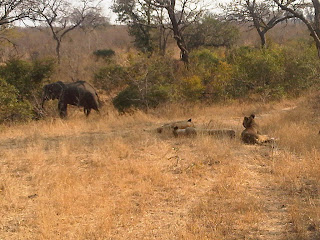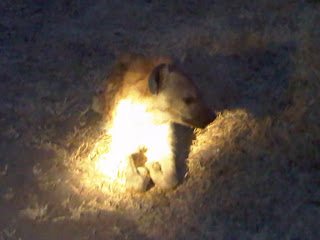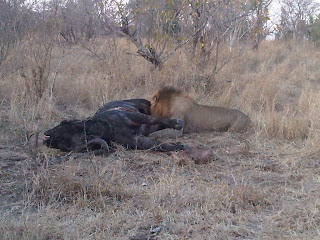 Othawa Lioness (Photo: Wessel)
Othawa Lioness (Photo: Wessel)
July has left us and with it the coldest part of the year. Already we are seeing the first few migratory birds returning. Lesser striped swallows, white-faced ducks and yellow-billed kites have all been spotted over the last few days.
The guests have been spoilt with photo opportunities recently and the rangers have also been taking advantage of the lovely winter light. So here are the updates, accompanied by pictures from Promise, Wessel and Rob:
Lions
 Selati Yawn (Photo: Promise)
Selati Yawn (Photo: Promise)
The four Selati males have been all over the reserve, spending time with both the Othawa pride and three Ximhungwe lionesses.
 Selati male and Ximhungwe lioness mating (Photo: Rob)
Selati male and Ximhungwe lioness mating (Photo: Rob)
Mating was witnessed on numerous occasions between all of the coalition and the Ximhungwe lionesses.
 Selati male feeding (Photo: Promise)
Selati male feeding (Photo: Promise)
The males also varied their diet a bit more and were seen feeding on a variety of animals including impala, nyala and an old hippo carcass.
 Selati male with an impala kill outside the lodge (Photo: Promise)
Selati male with an impala kill outside the lodge (Photo: Promise)
2 of the males brought down their usual buffalo prey at Schotia dam at the back of the lodge and fed there for a few days. One of the males also caught a buffalo calf one evening, the commotion attracted the attention of what seems to be the last remaining member of the Mapogo male lion coalition that the Selatis ousted in March. The lone Mapogo cautiously approached the area until he could see what was happening, the Selati noticed the watching intrude and the two spent at least 30 minutes staring at one another from a distance of about 150m, eventually the Mapogo male broke the standoff by running away. A sensible move as soon after another Selati male was seen approaching the area with two Ximhungwe lionesses in tow.
 Selati Male with the baby buffalo, just before the Mapogo male arrived (Photo: Wessel)
Selati Male with the baby buffalo, just before the Mapogo male arrived (Photo: Wessel)
 Selati Male watching the buffalo herd (Photo: Rob)
Selati Male watching the buffalo herd (Photo: Rob)
 Selatis on patrol (Photo: Promise)
Selatis on patrol (Photo: Promise)
The Ximhungwe pride has fragmented, with one female staying with the three sub_adults and the other three spending time with the Selati males. The group of 1+ 3 has done a great job of avoiding the males and are looking very good. Occasionally they join with the other lionesses and even courted danger by arriving at the smelly hippo carcass whilst at least one of the Selati males was in the area mating with one of the other pride members.
 Ximhungwe 1+3 (Photo: Rob)
Ximhungwe 1+3 (Photo: Rob)
At the end of June it was rumoured that one of the other three lionesses had given birth to cubs up on one of the rocky hills in the west, there was much debate as to whether the cubs were fathered by the Selati coalition or the Mapogo males as the lioness was seen mating with both groups prior to the takeover by the Selatis. It would be possible that different cubs in the litter could be fathered by different males. As the den was inaccessible it would be a while before any sightings of any cubs were possible.
 Ximhungwe lioness after a successful hunt (Photo: Wessel)
Ximhungwe lioness after a successful hunt (Photo: Wessel)
The three lionesses were found hunting together under the power lines on the edge of Idube property and soon enough they caught a wildebeest on the open clearings to the west of the power line road close to Ebony dam. The pride spent the whole morning feeding. by afternoon there was only one lioness at the kill, one other was found at the dam having a drink but the third was not around. It turned out that the third lioness had gone to her den, her tracks were seen returning towards the kill and she was soon found, carrying her single cub, barely 3 weeks old towards the kill. To young to eat meat, the cub was left in the long grass surrounding the carcass whilst the mother went to feed. It seemed strange that the lioness would risk bringing such a small cub to a kill with the possibility of other predators arriving at any moment. the next morning it became clear that the little cub was not well, close inspection of the mother showed that she had no recent suckle marks. bringing the cub to meat must have been an attempt to get it to eat as it was not drinking milk. The attempt proved futile and the cub was found dead the next day.
 Ximhungwe Lioness with the wildebeest kill (Photo: Promise)
Ximhungwe Lioness with the wildebeest kill (Photo: Promise)
 Ximhungwe lioness feeding at night (Photo: Promise)
Ximhungwe lioness feeding at night (Photo: Promise)
The Othawa females were seen frequently, some of the time in the company of the Selati males but often just the three lionesses. It seems that at least two of the three are pregnant and hopefully they will find space to raise their cubs here in our traversing area.
 Othawa lioness with a Selati male (Photo: Rob)
Othawa lioness with a Selati male (Photo: Rob)
Leopards
 Maxabeni 3:3 young male (Photo: Promise)
Maxabeni 3:3 young male (Photo: Promise)
The leopards in our area have been busy, there have been plenty of interesting interactions that we have been fortunate enough to witness. The three dominant males – Dewane, Kashane and Xindlevhana - have all been seen regularly which is unusual as Xindlevhana is quite hard to spot. These males have been complimented by sightings of up and coming young males – Maxabeni 3:3 young male, Tai Dam Male (Son of Shangwa) - and the son of the Tai Dam female was seen on a couple of occasions too. Female leopards seen included all the regulars – Hlab’nkunzi, Shangwa, Xikavi, Metsi, Tassleberry and Tlangisa (Who is now spending a lot of time in the far north-west). Sightings of Dam 3 female and Mobeni were logged too. The Ravenscourt female left plenty of tracks on the north-eastern portion of Idube property along with tracks of her cub but we were unable to get a sighting of her or the little one. Mobeni also seems to have at least one cub but again we have had no sightings.
 Kashane Male (Photo: Promise)
Kashane Male (Photo: Promise)
 Dewane Male (Photo: Promise)
Dewane Male (Photo: Promise)
One of the best sightings of the Xindlevhana male came about when he and the Dewane male crossed paths along the northern bank of the Sand river, Dewane managed to chase Xindlevhana up a tree where he was forced to pose in the late afternoon sun!
 Above: Xindlevhana up the tree
Above: Xindlevhana up the tree
Below: Dewane watches his rival intently. (Photos: Promise)
The Dewane male was also seen mating with the Shangwa female, the urge to mate took Shangwa far south of her usual territory as she followed Dewane on his routine patrols. At a shade under 14 years old there may not be many more litters for Shangwa so we all hope she successfully conceives and raises yet another relaxed litter for us to view!
 Dewane rejecting Shangwa’s advances (Photo: Rob)
Dewane rejecting Shangwa’s advances (Photo: Rob)
Also seen interacting were the Tassleberry female and the Maxabeni 3:3 young male, Tassleberry did not seem too happy with the attention the young male was giving her, just as the Metsi female was not pleased with him a few weeks earlier. Tassleberry was seen climbing up into the highest branches of a marula whilst a perplexed looking Maxabeni watched from the ground!
 Above: Tassleberry trying to avoid the Maxabeni 3:3 young male
Above: Tassleberry trying to avoid the Maxabeni 3:3 young male
Below: Maxabeni watches with a puzzled look on his face (Photos: Promise)
Another mating pair of leopards was seen – Xindlevhana male and the Dam 3 female. Both of these leopards are fairly shy but as they were in the vicinity of an impala kill and surrounded by hyena a view of them was possible.
 Dam 3 female on the impala kill (Photo: Rob)
Dam 3 female on the impala kill (Photo: Rob)
Quite a few other feeding leopards were seen over the course of the last month as you will see from the following pictures:
 Hlab’nkunzi with an impala kill (Photo: Promise)
Hlab’nkunzi with an impala kill (Photo: Promise)
 Dewane male with an impala kill (Photo: Promise)
Dewane male with an impala kill (Photo: Promise)
 Hlab’nkunzi with another impala kill (Photo: Rob)
Hlab’nkunzi with another impala kill (Photo: Rob)
 Metsi female with an impala kill (Photo: Promise)
Metsi female with an impala kill (Photo: Promise)
The Kashane male was seen sitting above the entrance to a warthog burrow in a termite mound, waiting for the occupants to show themselves. It seems his wait was in vain as he was not seen with a kill!
 Kashane, waiting for a warthog (Photo: Promise)
Kashane, waiting for a warthog (Photo: Promise)
Kashane’s failure at his attempt to get a meal of warthog was not repeated by the Maxabeni 3;3 young male, he was able to stalk up to a warthog burrow and time his run well enough to catch himself a huge female warthog. The warthog did not go down without a fight and it took close to 20 minutes for the leopard to win the battle!
 Maxabeni, battling to take down a huge warthog. (Photo: Rob)
Maxabeni, battling to take down a huge warthog. (Photo: Rob)
The warthog kill was such a big meal that Maxabeni was in one spot for 5 days providing fantastic viewing opportunities.
 Maxabeni feeding on the ground (Photo: Wessel)
Maxabeni feeding on the ground (Photo: Wessel)
 Maxabeni feeding in a tree (Photo: Promise)
Maxabeni feeding in a tree (Photo: Promise)
Other Predators
Many of the smaller predators were spotted regularly – Serval, civet, genet, side-striped jackal and a variety of mongoose species being the usual line-up.
 Africa’s smallest predator – the dwarf mongoose (Photo: Promise)
Africa’s smallest predator – the dwarf mongoose (Photo: Promise)
Hyena sightings have been on the rise recently too, perhaps as a result of the frequent buffalo carcasses being left around by the Selati male lions…
 Hyena watching vultures (Awesome Photo: Wessel)
Hyena watching vultures (Awesome Photo: Wessel)
For the first time in many months we had a cheetah in the Western sector, a young male came through and killed a young Nyala on the clearings just to the north of Idube lodge. He was found feeding, glancing around nervously. 200m away from the kill was the three Othawa lionesses and a Selati male, oblivious to the presence of the cheetah. We watched the cheetah feed until it was too dark to see, the next morning the tracks showed that the lions eventually did notice the cheetah and chased him away. Hopefully the young cheetah will return again soon.
 Cheetah and kill (Photo: Promise)
Cheetah and kill (Photo: Promise)
Crocodiles have been sighted regularly along the banks of the Sand river as the reptilian predators need the winter sun to regulate their body temperature.
 Massive crocodile (Photo: Promise)
Massive crocodile (Photo: Promise)
Other Animals
Hippo sightings have been fantastic over the past few weeks as these usually water-bound beasts com out onto the banks of the rivers and dams taking advantage of the week winter sun to warm themselves
 Hippos out of water (Photo: Promise)
Hippos out of water (Photo: Promise)
There were also some spectacular hippo interactions with fights and play fights breaking out at random. One fight resulted in a huge hippo taking shelter under a tree in which Hlab’nkunzi female leopard was feeding!
 Hippo aggression (Photo: Rob)
Hippo aggression (Photo: Rob)
There were also some lovely sightings of tiny baby hippo to compliment all the other hippo sightings.
 Little hippo (Photo: Promise)
Little hippo (Photo: Promise)
There were many sightings of elephants as herds wandered through the area breaking down the round-leafed teak thickets to feed on the cambium layer beneath the bark of the stems. big bulls also wandered the area, sometimes in quite big groups.
 Elephant family (Photo: Rob)
Elephant family (Photo: Rob)
 Bull elephant (Photo: Promise)
Bull elephant (Photo: Promise)
 Female elephant with backwards tusk (Photo: Promise)
Female elephant with backwards tusk (Photo: Promise)
The buffalo population was represented by two large herds, one close to 200 strong and the other numbering around 400, it was from one of these herds that the Selati male lions made their buffalo kills. Many old “dagga boy” bull buffalos were seen around the area and had somewhat of a break whilst the lions targeted other prey.
 Big Buffalo herd coming to drink (Photo: Wessel)
Big Buffalo herd coming to drink (Photo: Wessel)
 Buffalo bull (Photo: Promise)
Buffalo bull (Photo: Promise)
The general game population was well represented. There were many giraffe, zebra and wildebeest sightings as well as the various other antelopes – Kudu, nyala, bushbuck, reedbuck, waterbuck, impala, duiker and steenbok. Warthogs were spotted regularly, as were baboons and monkeys.
 Male steenbok (Photo: Promise)
Male steenbok (Photo: Promise)
Birds
As mentioned at the start, many of the migratory birds are starting to return to the area. there were also sightings of Goliath heron, saddle-billed stork, a black morph of the Gabar goshawk and plenty of vulture activity.
 White-backed vulture (Photo: Promise)
White-backed vulture (Photo: Promise)
One fascinating sighting was that of a pair of male Egyptian geese having a territorial battle along the bank of the river. The two bird were busy biting and kicking one another, eventually after being dunked under the water the losing bird broke free and flew off.
 Egyptian goose fight (Photo: Wessel)
Egyptian goose fight (Photo: Wessel)











































































